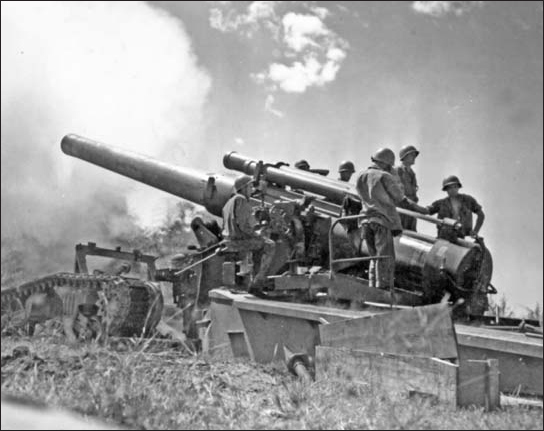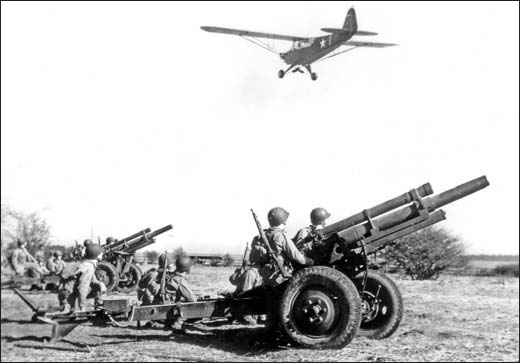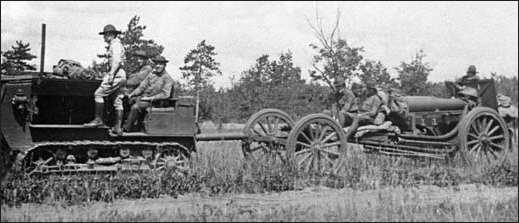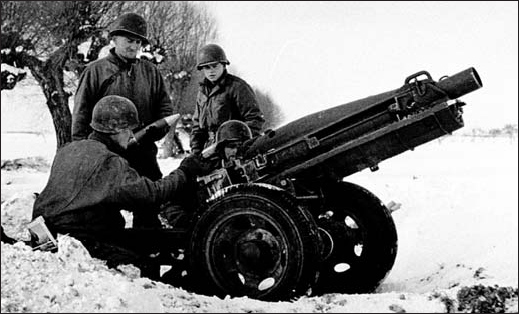

INTRODUCTION
THE WORLD WAR I LEGACY
US DIVISIONAL FIELD ARTILLERY
US CORPS HEAVY ARTILLERY
THE INTERNATIONAL DIMENSION
CANNON ON THE MOVE
FURTHER READING
COLOR PLATE COMMENTARY
Field artillery was the only combat arm of the US Army in World War II in which the United States was clearly the world leader in both technology and tactics. During World War I, the US Army was unprepared for providing its own artillery weapons and therefore was dependent on the supply of French and British artillery. After the Great War, the Army was determined to develop a whole new generation of weapons and so, unlike most European countries, started from scratch in the 1920s and 1930s. In contrast to many European armies, which still relied on various older World War I weapons during the 1939–45 campaigns, the US Army was fully reequipped with new artillery weapons during the campaigns of 1943–45. Apart from the development of a full range of excellent new weapons, the Army also enjoyed the full motorization of its artillery arm, which was a significant advantage in the mobile campaigns of World War II. The new artillery weapons were integrated with an advanced new doctrine that introduced a number of critical innovations, including aerial observation, Fire Direction Centers, and radio communications, which substantially enhanced the firepower of the US field artillery. The focus of this book is on field artillery; weapons such as antitank guns, antiaircraft guns, assault guns, coastal guns, and self-propelled tank destroyers not used by field artillery units are not covered in this volume.

An important factor in the effectiveness of US field artillery in World War II was the modernized infrastructure of the artillery battalions. Light aircraft were used for air observation, which increased the effectiveness of the howitzer batteries in long-range engagements. This is a 105mm Howitzer M1A1 on Carriage M2 from one of the battalions of the 29th Division during training exercises near Chiseldon in Great Britain in March 1943. (NARA)
When the United States entered World War I in 1917, it was poorly equipped in modern field artillery. As a result, the American Expeditionary Force (AEF) was heavily dependent on French- and British-manufactured weapons. Rather than develop new indigenous designs, the US Army also turned to the licensed manufacture of these artillery pieces, notably the French 75mm M1897 field gun, the British 18-pdr rechambered for French 75mm ammunition, the French 155mm GPF (Grande Puissance Filloux: Filloux High-power) gun, the French Schneider 155mm howitzer, the British 8-in. and 9.2-in. howitzers, and the French 240mm howitzer. A small number of US designs were also manufactured, including a US 75mm Model 1916 field gun rechambered for French 75mm ammunition and the 4.7-in. Model 1906 gun. By the end of the war in November 1918, US-manufactured weapons were beginning to arrive in France; so, for example, the AEF received a total of 1,828 75mm guns from the French and 143 US-manufactured 75mm guns. However, most of the weapons used by US troops during the conflict were of foreign design and manufacture.
The unsatisfactory state of US artillery in World War I prompted the Army Chief of Staff to set up a board to study the problem, headed by Brig Gen William Westervelt. The Westervelt Board, also called the Caliber Board, first met in France in January 1919 and took the opportunity to interview British, French, and Italian artillery specialists, as well as to study German artillery designs. The board submitted its report in May 1919, which concluded that “every item of hardware of war needed improvement.” The report of the Westervelt Board had a long-lasting impact on US Army artillery due to its perceptive prescriptions for development. In spite of its sound recommendations, the impact of the Westervelt Board in the short-term was minimal due to the sharp decline in the Army budget after the war. American foreign policy shifted towards isolationism and ardently rejected participation in future European conflicts. The large inventory of artillery weapons built up during World War I seemed more than adequate for the Army’s interwar responsibilities.
In light of this situation, the US Army Ordnance Department shifted its focus from the manufacture of artillery weapons to the development of the new weapons recommended by the Westervelt Board. Since funds were limited, the primary focus was on divisional artillery, with less emphasis placed on corps and army artillery. There was substantial debate in the interwar years over the best mix of weapons for the infantry division. The primary divisional field artillery weapon in World War I was the 75mm gun, with the French “soixante-quinze” 75mm M1897 remaining the most prominent piece in US Army service until the early 1940s. By the late 1930s, the Army was leaning in the direction of a new “triangular” infantry division, with three 75mm gun battalions (12 guns in each battalion) for direct support of the three infantry regiments and a 105mm howitzer battalion for general support. Lacking enough 105mm howitzers, the old Schneider 155mm howitzer was the substitute. However, many artillery officers argued that the 75mm gun lacked the firepower needed on the modern battlefield, and proposed using a 105mm howitzer as the primary field gun in the division, with a battalion of 155mm howitzers for general support. This configuration gained considerable support after the fall of France in June 1940, when it received the backing of the G-3 (Operations and Training Section) of the General Staff.

State of the art in 1918, this Holt Model 55 armored 10-ton tractor is seen towing a Schneider 155mm howitzer during wargames at Pine Camp in upstate New York in the summer of 1935. Some 1,421 of these tractors were delivered by the time of the Armistice, and a total of 2,014 by the end of January 1919. (NARA)

The 75mm Pack Howitzer M1A1 on Carriage M8 was used primarily in light divisions such as the airborne divisions in place of the 105mm howitzer. This howitzer is from the 463d Parachute Field Artillery Battalion supporting the 1st Airborne Tank Force near Hagenau on January 29, 1945, during the repulse of Operation Nordwind. (NARA)
The infantry branch of the Army fostered the development of a number of weapons separate from the artillery branch; mainly small, lightweight weapons used in the frontlines for direct support. The main focus of infantry interest in the 1920s was the development of a new 75mm pack howitzer that could be broken down into several loads and transported by horse or mule.
The 1930s were a time of great ferment in the artillery branch, even if equipment modernization was slowed by a lack of funding. The groundwork was laid for the most important tactical innovation, the Fire Direction Center (FDC), a critical ingredient in artillery fire support in mobile warfare. Instead of each battery commander having control over the firing decision, new methods were developed to allow an artillery battalion to rapidly mass its fire against a single target and shift it rapidly if needed. The battalion FDC would deploy a forward observer to determine accurately the location of the target; this system was later enhanced, beginning in June 1942, by using forward observers in light aircraft, who could locate targets out of the visual range of ground observers. The fielding of tactical radios also allowed the forward observers to rapidly communicate with the battalion FDC, and to move when necessary without the encumbrance of field telephone wires. The FDC also centralized the computation of firing data to permit its batteries to engage on a single target within ten minutes of the fire call from the forward observer. The battalion FDC was adopted in 1941, and a divisional FDC was first demonstrated the same year. The FDC innovation proved vital in the campaign in Tunisia in 1943 and Gen Bradley noted that it permitted any forward observer to bring the fire of the entire corps artillery, some 324 guns and howitzers, against a single target. Artillery proved itself invaluable again and again in the subsequent campaigns due to excellent training, tactics, and technology.
The start of the war in Europe in September 1939 encouraged the US Army to begin a substantial expansion of its artillery. In 1937, the Army fielded only 25 field artillery battalions, but by the outbreak of war in December 1941 this number had increased fivefold to 142 battalions, and eventually totaled over 700 battalions by 1945.